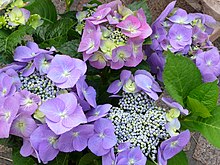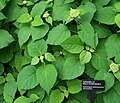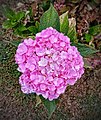| Hydrangea | |
|---|---|

| |
| Hydrangea macrophylla | |
| Scientific classification | |
| Kingdom: | Plantae |
| Clade: | Tracheophytes |
| Clade: | Angiosperms |
| Clade: | Eudicots |
| Clade: | Asterids |
| Order: | Cornales |
| Family: | Hydrangeaceae |
| Genus: | Hydrangea Gronov. ex L. |
| Type species | |
| Hydrangea arborescens L. | |
| Species | |
|
See text | |
| Synonyms | |
synonymy
| |
Hydrangea (/haɪˈdreɪndʒə/ or /haɪˈdreɪndʒiə/), commonly named the hortensia, is a genus of more than 70 species of flowering plants native to Asia and the Americas. By far the greatest species diversity is in eastern Asia, notably China, Korea, and Japan. Most are shrubs 1–3 m (3 ft 3 in – 9 ft 10 in) tall, but some are small trees, and others lianas reaching up to 30 m (100 ft) by climbing up trees. They can be either deciduous or evergreen, though the widely cultivated temperate species are all deciduous.
The flowers of many hydrangea act as natural pH indicators, sporting blue flowers when the soil is acidic and pink ones when the soil is alkaline.
Etymology
Hydrangea is derived from Greek and means ‘water vessel’ (from ὕδωρ húdōr "water" + ἄγγος ángos or ἀγγεῖον angeîon "vessel"), in reference to the shape of its seed capsules. The earlier name, Hortensia, is a Latinised version of the French given name Hortense, honoring French astronomer and mathematician Nicole-Reine Hortense Lepaute. Philibert Commerson attempted to name the flower Lepautia or Peautia after Lepaute. However, the flower's accepted name later became Hortensia. This led to people believing Lepaute's name was Hortense, but the Larousse remarks that this is erroneous, and that the name probably came from hortus, garden.
Life cycle
Hydrangea flowers are produced from early spring to late autumn; they grow in flowerheads (corymbs or panicles) most often at the ends of the stems. Typically the flowerheads contain two types of flowers: small non-showy fertile flowers in the center or interior of the flowerhead, and large, sterile showy flowers with large colorful sepals (tepals). These showy flowers are often extended in a ring, or to the exterior of the small flowers. Plants in wild populations typically have few to none of the showy flowers, while cultivated hydrangeas have been bred and selected to have more of the larger type flowers.
There are two flower arrangements in hydrangeas with corymb style inflorescences, which includes the commonly grown "bigleaf hydrangea"—Hydrangea macrophylla. Mophead flowers are large round flowerheads resembling pom-poms or, as the name implies, the head of a mop. In contrast, lacecap flowers bear round, flat flowerheads with a center core of subdued, small flowers surrounded by outer rings of larger flowers having showy sepals or tepals. The flowers of some rhododendrons and viburnums can appear, at first glance, similar to those of some hydrangeas.
Hydrangea flowers, when cut, dehydrate easily and wilt very quickly due to the large surface area of the petals. A wilted hydrangea may have its hydration restored by first having its stem immersed in boiling water; as the petals of the hydrangea can also absorb water, the petals may then be immersed, in room-temperature water, to restore the flower's hydration.
Colors and soil acidity

Hydrangea flower color can change based on the pH in soil. As the graph depicts, soil with a pH of 5.5 or lower will produce blue flowers, a pH of 6.5 or higher will produce pink hydrangeas, and soil in between 5.5 and 6.5 will have purple hydrangeas. White hydrangeas cannot be color-manipulated by soil pH because they do not produce pigment for color. In other words, while the hue of the inflorescence is variable dependent upon cultural factors, the color saturation is genetically predetermined. In most species, the flowers are white. In some, however, (notably H. macrophylla), they can be blue, red, or purple, with color saturation levels ranging from the palest of pinks, lavenders & powder blues, to deep, rich purples, reds, and royal blues. In these species, floral color change occurs due to the availability of aluminium ions, a variable which itself depends upon the soil pH. For H. macrophylla and H. serrata cultivars, the flower color can be determined by the relative acidity of the soil: an acidic soil (pH below 7), will have available aluminum ions and typically produce flowers that are blue to purple, whereas an alkaline soil (pH above 7) will tie up aluminium ions and result in pink or red flowers. This is caused by a color change of the flower pigments in the presence of aluminium ions which can be taken up into hyperaccumulating plants.
Partial list of species

- Hydrangea anomala – (climbing hydrangea) Himalaya, southwest China
- Hydrangea arborescens – (smooth hydrangea) eastern North America
- Hydrangea aspera – China, Himalaya
- Hydrangea bretschneideri – China
- Hydrangea chinensis – China and Taiwan
- Hydrangea chungii – China
- Hydrangea cinerea – (ashy hydrangea) eastern United States
- Hydrangea coenobialis – China
- Hydrangea davidii – China
- Hydrangea febrifuga – central & southern China to Malesia and New Guinea
- Hydrangea glaucescens – China, Myanmar and Vietnam
- Hydrangea gracilis – China
- Hydrangea heteromalla – Himalaya, west and north China
- Hydrangea hirta – Japan
- Hydrangea hydrangeoides – Ulleungdo, Japan, Kurils
- Hydrangea hypoglauca – China
- Hydrangea integrifolia – China
- Hydrangea involucrata – Japan, Taiwan
- Hydrangea jelskii – Andes
- Hydrangea kwangsiensis – China
- Hydrangea kwangtungensis – China
- Hydrangea lingii – China
- Hydrangea linkweiensis – China
- Hydrangea longifolia – China
- Hydrangea longipes – western China
- Hydrangea macrocarpa – China
- Hydrangea macrophylla – (bigleaf hydrangea) southeast Japan, southern China
- Hydrangea mangshanensis – China
- Hydrangea paniculata – (panicled hydrangea) eastern China, Japan, Korea, Sakhalin
- Hydrangea peruviana – Costa Rica and Panama, Andes
- Hydrangea petiolaris – (climbing hydrangea) Japan, Korea, Sakhalin
- Hydrangea quercifolia – (oakleaf hydrangea) southeast United States
- Hydrangea radiata – (silverleaf hydrangea) southeast United States
- Hydrangea robusta – China, Himalaya
- Hydrangea sargentiana – western China
- Hydrangea scandens – southern Japan south to the Philippines
- Hydrangea serrata – Japan, Korea
- Hydrangea serratifolia – Chile, western Argentina
- Hydrangea strigosa – China
- Hydrangea stylosa – China
- Hydrangea tarapotensis – Andes
- Hydrangea xanthoneura – China
- Hydrangea zhewanensis – China
Fossil record

†Hydrangea alaskana is a fossil species recovered from Paleogene strata at Jaw Mountain Alaska. †Hydrangea knowltoni has been described from leaves and flowers recovered from the Miocene Langhian Latah Formation of the inland Pacific Northwest United states. The related Miocene species †Hydrangea bendirei is known to from the Mascall Formation in Oregon, and †Hydrangea reticulata is documented from the Weaverville Formation in California.
Four fossil seeds of †Hydrangea polonica have been extracted from borehole samples of the Middle Miocene fresh water deposits in Nowy Sacz Basin, West Carpathians, Poland.
Cultivation and uses
Hydrangeas are popular ornamental plants, grown for their large flowerheads, with Hydrangea macrophylla being by far the most widely grown. It has over 600 named cultivars, many selected to have only large sterile flowers in the flowerheads. Hydrangea macrophylla, also known as bigleaf hydrangea, can be broken up into two main categories; mophead hydrangea and lacecap hydrangea. Some are best pruned on an annual basis when the new leaf buds begin to appear. If not pruned regularly, the bush will become very "leggy", growing upwards until the weight of the stems is greater than their strength, at which point the stems will sag down to the ground and possibly break. Other species only flower on "old wood". Thus, new wood resulting from pruning will not produce flowers until the following season.
The following cultivars and species have gained the Royal Horticultural Society's Award of Garden Merit under the synonym Schizophragma:
- S. hydrangeoides var. concolor 'Moonlight'
- S. hydrangeoides var. hydrangeoides 'Roseum'
- S. integrifolium
Hydrangea root and rhizome are indicated for the treatment of conditions of the urinary tract in the Physicians' Desk Reference for Herbal Medicine and may have diuretic properties. Hydrangeas are moderately toxic if eaten, with all parts of the plant containing cyanogenic glycosides. Hydrangea paniculata is reportedly sometimes smoked as an intoxicant, despite the danger of illness and/or death due to the cyanide.
The flowers on a hydrangea shrub can change from blue to pink or from pink to blue from one season to the next depending on the acidity level of the soil. Adding organic materials such as coffee grounds and citrus peel will increase acidity and turn hydrangea flowers blue. A popular pink hydrangea called Vanilla Strawberry has been named "Top Plant" by the American Nursery and Landscape Association.
A hybrid "Runaway Bride Snow White", from Japan, won Plant of the Year at the 2018 RHS Chelsea Flower Show.
In culture
In Japan, ama-cha (甘茶), meaning sweet tea, is another herbal tea made from Hydrangea serrata, whose leaves contain a substance that develops a sweet taste (phyllodulcin). For the fullest taste, fresh leaves are crumpled, steamed, and dried, yielding dark brown tea leaves. Ama-cha is mainly used for kan-butsu-e (the Buddha bathing ceremony) on April 8 every year—the day thought to be Buddha's birthday in Japan. During the ceremony, ama-cha is poured over a statue of Buddha and served to people in attendance. A legend has it that on the day Buddha was born, nine dragons poured Amrita over him; ama-cha is substituted for Amrita in Japan.
In Korean tea, Hydrangea serrata is used for an herbal tea called sugukcha (수국차) or isulcha (이슬차).
The pink hydrangea has risen in popularity all over the world, especially in Asia. The given meaning of pink hydrangeas is popularly tied to the phrase "you are the beat of my heart," as described by the celebrated Korean florist Tan Jun Yong, who was quoted saying, "The light delicate blush of the petals reminds me of a beating heart, while the size could only match the heart of the sender!"
Hydrangea quercifolia was declared the official state wildflower of the U.S. state of Alabama in 1999.
Hydrangeas were used by the Cherokee people of what is now the Southern U.S. A mild diuretic and cathartic, it was considered a valuable remedy for stone and gravel in the bladder.
Gallery
-
Hydrangea macrophylla
-
 Hydrangea flowers close up.
Hydrangea flowers close up.
-
 Flowers
Flowers
-
 Hydrangea macrophylla, flowers
Hydrangea macrophylla, flowers
-
 Hydrangea macrophylla, flowers
Hydrangea macrophylla, flowers
-
Hydrangea sp painted by the botanical artist Redouté.
-
 Hydrangea quercifolia
Hydrangea quercifolia
-
 Hydrangea macrophylla, leaves
Hydrangea macrophylla, leaves
-
 Wild Hydrangea v. Annabelle
Wild Hydrangea v. Annabelle
Hydrangea arborescens -
 Wild Hydrangea v. Annabelle
Wild Hydrangea v. Annabelle
Hydrangea arborescens -
8" Annabelle Hydrangea Bloom. Hydrangea arborescens.
-
 Hydrangea aspera ssp. sargentiana
Hydrangea aspera ssp. sargentiana
-
-
Hydrangea paniculata
-
Hydrangea flowers from Kerala, India
-
Hydrangeas in front of the Office de Tourisme Building in Chartres, France
-
Hydrangea flowers at the "Cerro El Avila" National Park, Venezuela
-
 Hydrangea flowers, Srinagar, Kashmir, India
Hydrangea flowers, Srinagar, Kashmir, India
-
 Hydrangea flowers
Hydrangea flowers
-
 Hydrangea flowers in Petrópolis, Brazil
Hydrangea flowers in Petrópolis, Brazil
-
 Hydrangeas near the Black Lake of Gramado, southern Brazil
Hydrangeas near the Black Lake of Gramado, southern Brazil
-
 Purple hydrangea flowers
Purple hydrangea flowers
-
 Hydrangea arborescens leaf
Hydrangea arborescens leaf
-

-

-

-

-
 Flower of hydrangea
Flower of hydrangea
-
 Flower of hydrangea
Flower of hydrangea
-
 Vein structure of a hydrangea leaf
Vein structure of a hydrangea leaf
-
 Hydrangea arborescens (Smooth Hydrangea) in Calgary, Canada
Hydrangea arborescens (Smooth Hydrangea) in Calgary, Canada
Diseases
Main article: List of hydrangea diseasesReferences
[REDACTED] This article incorporates text from a publication now in the public domain: Chisholm, Hugh, ed. (1911). "Hydrangea". Encyclopædia Britannica. Vol. 14 (11th ed.). Cambridge University Press. p. 34.
- Hydrangea | International Plant Names Index. (n.d.). Retrieved January 5, 2024, from https://www.ipni.org/n/30010546-2
- "Hydrangea Gronov. ex L." Plants of the World Online. Board of Trustees of the Royal Botanic Gardens, Kew. 2021. Retrieved 17 September 2021.
- "hydrangea". Cambridge Dictionaries (Online). Cambridge University Press. n.d. Retrieved 15 September 2024.
- "hydrangea". Merriam-Webster.com Dictionary. Merriam-Webster. Retrieved 15 September 2024.
- Sunset Western Garden Book, 1995:606–607
- "The United States National Arboretum: Hydrangea FAQ". Archived from the original on 16 May 2013. Retrieved 27 November 2008.
- "Curious Chemistry Guides Hydrangea Colors". American Scientist. 2017-02-06. Retrieved 2024-05-27.
- Liddell, Henry George; Scott, Robert (1940). "ὕδωρ". A Greek-English Lexicon. Perseus Digital Library.
- Liddell, Henry George; Scott, Robert (1940). "ἄγγος". A Greek-English Lexicon. Perseus Digital Library.
- Liddell, Henry George; Scott, Robert (1940). "αγγεῖον". A Greek-English Lexicon. Perseus Digital Library.
- Gledhill, David (2008). The Names of Plants. Cambridge University Press. pp. 50, 206. ISBN 9780521866453.
- "hortensia | Definition of hortensia in English by Oxford Dictionaries". Oxford Dictionaries | English. Archived from the original on December 7, 2017. Retrieved 2017-12-07.
- Lynn, W. T. (2 January 1911). "Madame Lepaute". The Observatory. 34: 77–78. Bibcode:1911Obs....34...87L. Retrieved 8 November 2022.
- Kyle (2018-09-13). "Scentales | Florist Best Kept Secret: How to Save Wilting Hydrangeas". Scentales Florist. Retrieved 2019-11-25.
- "Publications - UGA Cooperative Extension". www.caes.uga.edu. Retrieved 31 May 2018.
- "USDA: Hydrangea Questions and Answers". Archived from the original on 16 May 2013. Retrieved 31 May 2018.
- Chisholm, Hugh, ed. (1911). "Hydrangea" . Encyclopædia Britannica. Vol. 14 (11th ed.). Cambridge University Press. p. 34; see line five.
...but by the influence of sundry agents in the soil, such as alum or iron, they become changed to blue
. - "Hydrangea Plants".
- Hollick, Arthur (1925). "A New Fossil Species of Hydrangea". Bulletin of the Torrey Botanical Club. 52 (1): 21–22. doi:10.2307/2479996. JSTOR 2479996.
- Knowlton, F.H. (1926). "Flora of the Latah Formation of Spokane, Washington, and Coeur d'Alene, Idaho". Shorter contributions to general geology, 1925 (PDF) (Report). Professional Paper. Vol. 140. United States Geological Survey. pp. 17–55, plates VIII-XXXI. doi:10.3133/pp140A.
- Chaney, R.; Axelrod, D. (1959). Miocene Floras of the Columbia Plateau: Part II. Systematic Considerations, by Ralph W. Chaney and Daniel I. Axelrod. Carnegie Institution of Washington. pp. 1–226.Miocene Floras of the Columbia Plateau at the HathiTrust Digital Library
- Łańcucka-Środoniowa M.: Macroscopic plant remains from the freshwater Miocene of the Nowy Sącz Basin (West Carpathians, Poland) . Acta Palaeobotanica 1979 20 (1): 3-117.
- "The Complete Guide to All Hydrangea Types | Plant Addicts". plantaddicts.com. Retrieved 2017-11-20.
- "AGM Plants - Ornamental" (PDF). Royal Horticultural Society. July 2017. p. 96. Retrieved 6 November 2018.
- "RHS Plantfinder - Schizophragma hydrangeoides var. concolor 'Moonlight'". Retrieved 6 November 2018.
- "RHS Plant Selector - Schizophragma hydrangeoides var. hydrangeoides 'Roseum'". Retrieved 3 June 2013.
- "RHS Plant Selector - Schizophragma integrifolium". Retrieved 5 March 2021.
- PDR for Herbal Medicine 3rd Edition Page 453
- "Hills of Snow". Retrieved 31 May 2018.
- "Erowid Hydrangea Vault". www.erowid.org. Retrieved 31 May 2018.
- Willsher, Kim (6 February 2014). "High danger hydrangea? French police hunt gang peddling 'cheaper weed'". the Guardian. Retrieved 31 May 2018.
- "Everything You Need to Know About Hydrangeas". www.gardenista.com. 2018-06-10. Retrieved 15 June 2018.
- "Hydrangeas: How To Change Color from Pink to Blue". www.gardenista.com. 2016-05-10. Retrieved 15 June 2018.
- "This plant has been named 'plant of the year' at the Chelsea Flower Show". 2018-05-22. Retrieved 31 May 2018.
- "Hydrangeas, Hydrangeas, Hydrangeas - Roll Gardening & Green :: Roll Magazine: Creative Living in the Hudson Valley". www.rollmagazine.com. Retrieved 31 May 2018.
- State Botanical SymbolsBy Alan McPherson, p.3
- Hylton, William H. (1974). The Rodale herb book: how to use, grow, and buy nature's miracle plants (Eighteenth Printing — September 1979 ed.). Emmaus, Pa.: Rodale Press Book Division. p. 474. ISBN 0-87857-076-4. OCLC 610291480.
External links
- [REDACTED] Media related to Hydrangea at Wikimedia Commons
- erowid.org
- Flora of Nepal: Hydrangea species list
- Hydrangea – selecting shrubs
- Hydrangea species and hybrids
- Propagating Hydrangeas
- Red Listing of Threatened Hydrangeas
